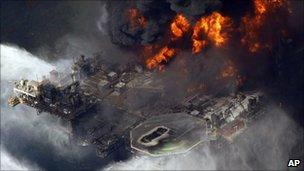Who's blamed by BP for the Deepwater Horizon oil spill?
- Published

At the time of the explosion, 126 crew members were on the rig, 50 miles off the coast of Louisiana
BP has revealed a number of key findings made during its internal investigation into who it believes was responsible for the Gulf of Mexico oil spill.
Eleven people were killed and 17 people were injured in an explosion on the Deepwater Horizon on 20 April. An estimated 4.9m barrels of oil leaked into the Gulf after the blast.
The report says no one action or inaction was behind the accident. Instead, "multiple companies, work teams and circumstances were involved over time".
It blames the combination of "a complex and interlinked series of mechanical failures, human judgements, engineering design, operational implementation and team interfaces".
Transocean (the rig's owner)
Transocean was responsible for the safety valve known as the blowout preventer. The report says six leaks were identified in its hydraulic system. While it was on the wellhead, the investigators say the preventer appeared to follow BP and Transocean's standards.
However, they say there were "no indications" that intervention systems had been tested at the surface, "as was required by Transocean policy", before it was deployed on the well.
Halliburton (cement provider)
The day before the accident, cement was pumped into the drill column of the well to prevent hydrocarbons entering it from the reservoir.
The BP investigation says there were "weaknesses in cement design and testing, quality assurance and risk assessment". It suggests that "improved engineering rigour, cement testing and communication of risk" by Halliburton could have identified those flaws.
But the report also says the Houston-based BP staff at the site could have raised awareness of the problems.
Transocean and BP (the well owner)
A "negative-pressure test" was carried out to check the mechanical barriers. The report says that Transocean rig crew and BP leaders on the site "reached the incorrect view" that the test had been a success and the well was secure.
The crew
The report says that the Transocean rig crew and a team described as "mudloggers" working for Halliburton Sperry Sun may have been distracted by what are described as "end-of-well activities" and, as a result, important monitoring was not carried out for more than seven hours.
The crew "underbalanced" the well by pouring seawater into it rather than heavy-drilling mud. This allowed gases through the blowout preventer.
For an estimated 40 minutes, the influx of gases into the well was apparently not spotted. By this time "hydrocarbons were rapidly flowing to the surface" and, according to witnesses, mud flowed uncontrolled on to the rig platform.
The BP report says that if the blowout preventer had been closed and sealed around the drill pipe before that point, gases probably would not have entered the pipe known as the riser.
Explosion
The gases moved to areas of the rig where there was a greater risk of explosion. The heating, ventilation and air conditioning system "probably transferred a gas-rich mixture" into engine rooms on the Deepwater Horizon.
The report says: "The surface facilities were overwhelmed with the volumes of fluids and gas, which resulted in the explosions and fire."